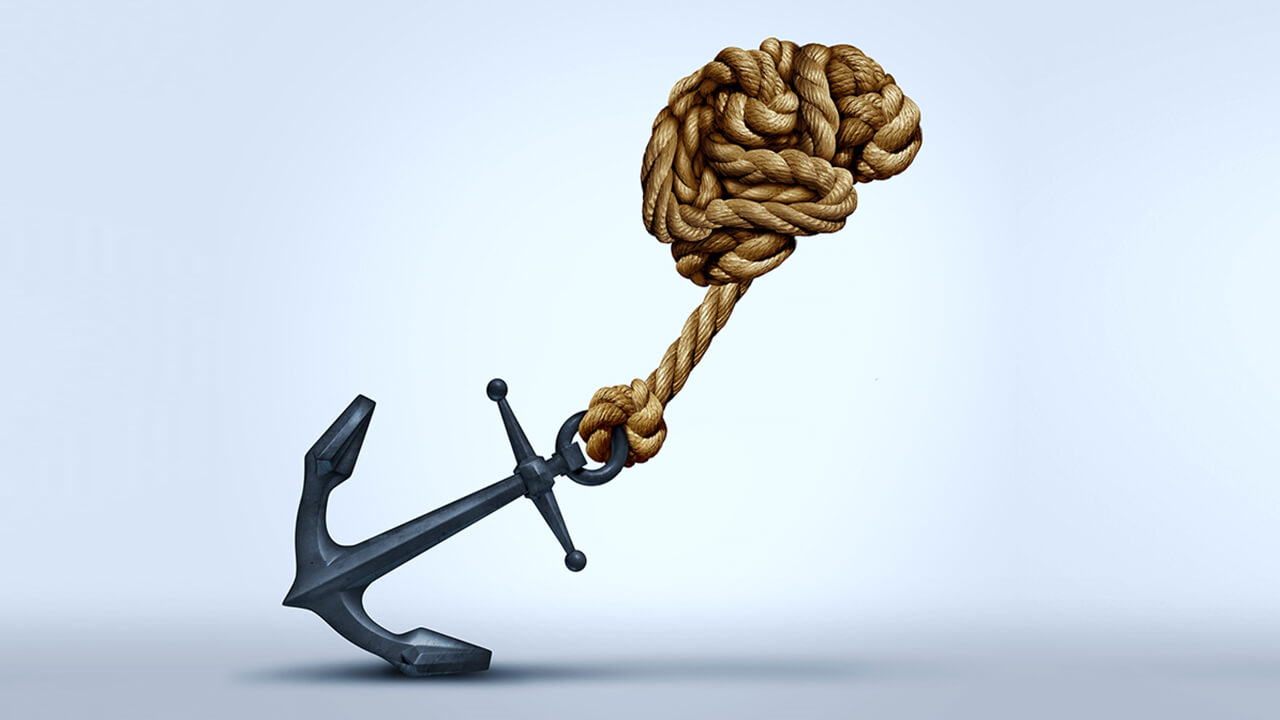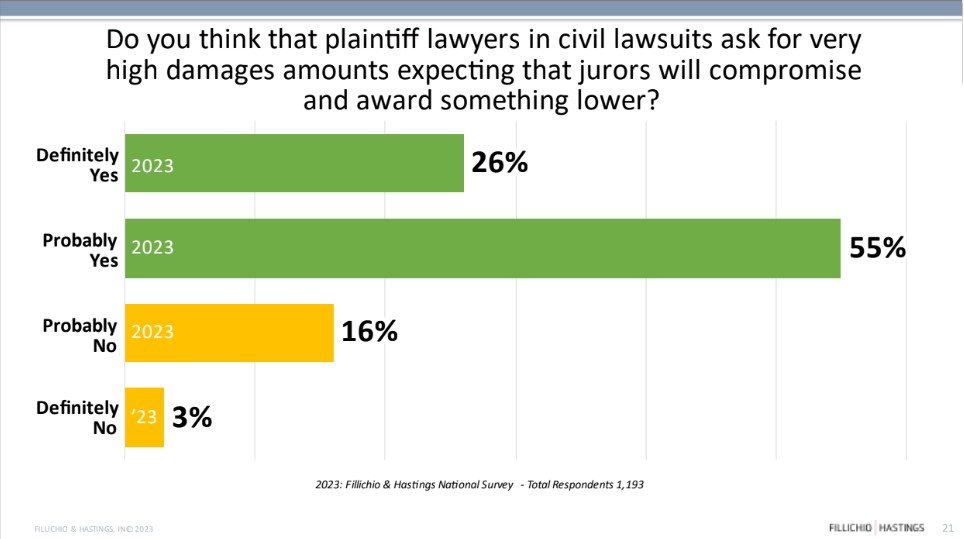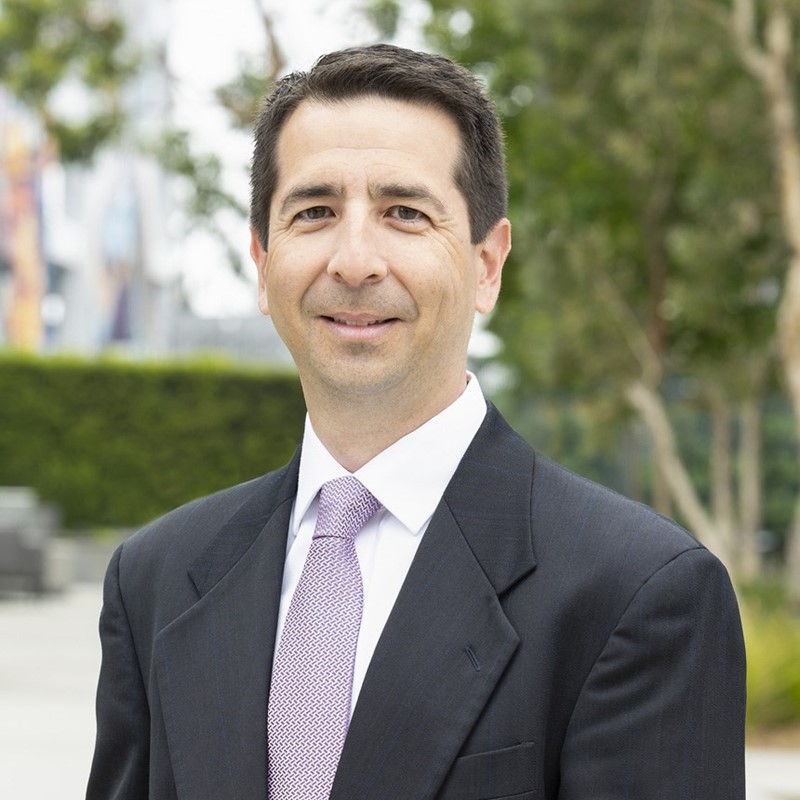Anchoring and the Undeniable Impact on Jurors

Susan G. Fillichio, Esq. and Steve Son, Ph.D.1
I. Introduction
To the consternation of corporate defendants and defense counsel, the upward trend of damages in jury verdicts continues. Clients continually ask us, “Why are the damages awards so large? Where did that number come from? What’s going on with jurors these days?” These are questions that the Fillichio & Hastings team continually assess. Our experience and decades of social science research confirm that juror decision-making is influenced by various cognitive biases: deviations from otherwise logical, accurate, and mathematically precise assessments of events.2 Herein, we explore the importance of one such bias, the anchoring bias, which is the tendency to unduly rely on the first or only piece of information received on a topic. What jurors do with information about the “value” of the case is, of course, subject to negotiation in every unique jury deliberation, but the impact of that first (or only) number is most often used as a starting point for jurors in determining damages. We also address commonly encountered tactics in trial which trigger the anchoring bias, including early framing of the scope of damages and posing questions in voir dire about a juror’s willingness to award a specific and massive sum of money.
II. Plaintiffs Using Anchors Impacts Decisions
Because counsel for plaintiffs speak to jurors first during jury selection, they have the opportunity to “drop an anchor” early in the process, which is a distinct advantage. During voir dire in most state courts across the country, plaintiff lawyers in personal injury cases are often permitted to inquire of jurors about their willingness to award millions of dollars in damages, or whether there is a maximum amount in their minds above which they will not go.3 Questions relating to whether or not a prospective juror has a “ceiling” in mind, an amount above which he or she will not go, may be appropriate for the purpose of understanding whether the prospective juror may harbor bias against the plaintiff (or plaintiffs in lawsuits generally).
Importantly, however, our decades of empirical jury studies, as validated by our experience at trial, shows that plaintiff anchoring often significantly impacts juror decision-making. When jurors hear plaintiff lawyers asking for “millions of dollars in damages” early in voir dire, counsel is priming the panel for a multi-million dollar damages demand, thereby triggering the anchoring bias.
Plaintiff counsel sets expectations from the beginning, helping to normalize the concept of a high dollar value view of the case. Jurors, of course, debate the topic of damages while deliberating. Compromises and negotiations are typical; however, jurors commonly adjust off the anchor resulting in a final amount that is biased toward that anchor.4
Jurors’ responses to such inquiries often include questions about whether or not they will receive jury instructions or other guidance from the court about how to arrive at those damages awards. While the court may provide instructions on specific types of damages generally, the real answer is that there are no formulas, comparisons, or “how to” guides for jurors in determining their awards. The jury instructions on the topic of damages are often viewed by jurors as complex and incomprehensible.5 Most jurors in jury selection relate that they feel completely unqualified to make damages determinations, particularly in personal injury cases where they are asked to place a value on past and future pain, suffering, the loss of life, and other similar intangible categories of compensatory damages. Likewise, even in mock trial studies (which are shorter and more focused than any actual trial), surrogate jurors consistently puzzle over how to arrive at their awards.
Most jurors are aware that plaintiff lawyers inflate their demands, expecting jurors to compromise at a number closer to the middle when the defense introduces a lower number (a “counter anchor”). In the most recent annual survey conducted by Fillichio & Hastings in the fall of 2023, 81% of nearly 1,200 respondents indicated that they believe plaintiff lawyers ask for very high damages expecting jurors to compromise and award something lower.6

Interestingly, even though jurors are often aware of these attempts by plaintiff lawyers to inflate damages (both compensatory and punitive awards), they do not appear to resent it. Our research and experience show that starting with a very high anchor remains an effective tactic to ultimately increase a damages verdict. Plaintiff lawyers know that the higher they go with their demand (within reason),7 the higher that middle ground becomes.
More recently, we have observed plaintiff lawyers in voir dire asking jurors whether they could award a specific sum, for example, $100 million, should the evidence support it. Telling jurors in voir dire something like, “I'm going to ask for $100 million - does anyone have a problem with that?” is wildly different than telling jurors, “I'm going to ask for a lot of money, even millions of dollars in damages.” The former tactic of naming the amount serves as a memorable, perhaps even shocking, anchor at that juncture, given that jurors have yet to hear a shred of evidence in the case. In our experience, most courts have either ruled in advance that such an inquiry is impermissible, or sustained an objection to the question in the moment. It is a worthwhile undertaking for each jurist to weigh the pros and cons. Consider that if defense counsel objects, the topic is arguably underscored for jurors. If counsel does not object, and the court remains silent on the issue or overrules an objection, there is tacit validation by the court of the anchor. Jurors may think, “Well, I guess that is what we are talking about here, a really huge and important case worth $100 million.” Notably, counsel asking the question suggests to jurors that, if they find for the plaintiff, they need to award that specific sum. Thus, the question arguably calls for a commitment from the juror, which is likewise improper in voir dire.
Importantly, there is a significant impact on the process if plaintiff counsel are permitted to inquire about a juror’s willingness to award a specific sum. Eliminating, either through cause challenges or peremptory strikes, those jurors who cannot award those higher amounts skews the makeup of the panel toward those who are predisposed to awarding higher damages. Given the prejudicial impact on the process, defense counsel suspecting that such tactics are imminent should consider filing a motion in limine to prevent inquiry during voir dire into specific sums. As with so many issues for jurors, there is no unringing that bell.
III. Considerations for the Defense in Presenting Counter Anchors
The decision for the defense on whether or not to present a counter anchor or suggest a compensatory damages award of any amount above zero, in an effort to minimize the anchoring bias, is tricky. Preliminarily, the question has been posed to our team: is zero an anchor? When defense counsel advocates for “zero dollars,” this does not serve as a counter anchor; rather, it requires jurors to decide definitively that there is no liability in the case and the plaintiff deserves no compensation whatsoever. While completely appropriate in certain cases, zero means that jurors who are on the fence about the case may have little wiggle room or ammunition with which to persuade fellow jurors of a desired lower damages award.
Certainly, some jurors consider any damages number suggested by a defendant as an admission of liability. Still, in our post-trial interviews with jurors, we have often heard them remark that they focused only on the plaintiff’s damages request in their deliberations because there was no other number to reference. For example, a juror in a recent trial told us after the verdict: "We awarded the plaintiff the full amount he asked for because the defense didn't put up any alternative number. We only had one set of numbers to work with. We tried calculating something else, a different amount, but thought that we shouldn't have to do that and just awarded the full amount." When counter anchors are presented by the defense, jurors have an additional tool with which to counter arguments from plaintiff jurors in the discussion of damages. A further question then becomes what amount is too low such that jurors dismiss it, rendering the counter anchor ineffective (e.g., is it $10,000, $100,000, $250,000, or something else depending on the case?).
In our experience, the framing of the counter anchor by defense counsel makes all the difference. The belief that there is no meritorious claim, and that no money is due based on the evidence, is not always inconsistent with presenting a counter anchor. Counsel can clearly state that there should be no award of damages based on the evidence, but if jurors disagree and find liability, the award should not be the “pie in the sky” number thrown out by the plaintiff and should be no more than the suggested counter anchor. While the use of a counter anchor may be subject to criticism by plaintiff lawyers, the current trend in sky-high verdicts suggests that the approach should be thoroughly evaluated.
Where punitive damages are at issue, anchors and counter anchors are typically provided through company financial records. The anchors here are likewise influenced by information that is readily accessible to jurors in their daily lives through the public domain, including publications of other large verdicts and the dissemination of sponsored advocacy pieces about the purported dangers of products and substances which may be at issue in, or relate in some way, to the case (and other external influences discussed below).8 Jurors refer to these anchors in determining what they perceive to be enough to send a message to the defendant to prevent similar conduct in the future. Perceptions that companies are minimizing or obfuscating information in financial records or through witness testimony provide jurors with additional affirmation of their determination of malice, recklessness, or fraud in the first instance, thus resulting in even higher punitive damages awards.
IV. External Influences on Anchors
Even in the absence of concrete anchors presented by the parties, jurors provide their own anchors. Jurors constantly encounter references in daily life and the public domain from which to draw comparisons for the purpose of determining how much it will take to make the plaintiff whole. For example, when jurors are asked in voir dire about whether their lives have been affected by cancer, nearly all the hands in the courtroom go up. Given such widespread common experience, counsel can anticipate that deliberations include discussions of the staggering costs of medical care, hospital visits, surgeries, health insurance, etc., needed to make the plaintiff and their family members whole.9 Consider further that rising food and gas prices, interest rates and inflation, lower rates of return on investments, college tuition which has more than doubled over the last 20 years, and soaring median home prices (when adjusted for inflation, up 40% over the past 20 years) lead to feelings amongst jurors that they need more money to be financially secure.10 It is thus not a stretch for jurors to conclude that, to be made whole, the plaintiff also needs more money now, and will need more in the future.
As noted above, highly publicized media and social media reports provide anchors on vast amounts of money that companies pay out or receive (even when not the defendant at trial), such as multi billion-dollar corporate profits, executive compensation packages, massive salaries and bonuses paid to athletes and coaches, and funds spent on construction of new facilities. Finally, the publication of multi-million and even billion-dollar verdicts, especially in similar cases, not only contributes to the anchoring bias, but also serves as a reference for what other juries have awarded in damages in the past (and to some jurors, what should be matched or surpassed with their verdict). The frequent reporting of these exorbitant verdicts underscores the message that corporate conduct is in need of reform, thus creating a vicious cycle of sky-high awards becoming the perceived norm.
V. Conclusion
There is undeniable power in utilizing numeric anchors at trial. Experience and studies show that presenting jurors with anchors is highly influential to their decision-making in determining damages. Although general questions about a juror’s views of the limits of damages may be appropriate to identify bias amongst jurors, inquiry into specific sums results in triggering the anchoring bias and potentially a lopsided venire in which only those who are predisposed to awarding the highest amounts in damages are viewed as fit to serve as jurors in the case. Acknowledgement of the existence of the anchoring bias and the impact on verdicts following the use of anchoring tactics will further assist the court and counsel in the goal of selecting a truly unbiased jury and ensuring fairness to both sides of the dispute.
1 Susan G. Fillichio, Esq., is a trial consultant and founder of Fillichio & Hastings. Steve Son, Ph.D., is a senior consultant at Fillichio & Hastings. For over 20 years, both have consulted in state and federal venues across the country in all types of civil cases, through hundreds of empirically sound jury research studies and in trials. The authors gratefully acknowledge the contributions of Nicole Mills, M.A., and Jacqueline Kirshenbaum, Ph.D. and for all data and charting meticulously compiled by Layne Hastings and the Visual Communications team at Fillichio & Hastings, Inc. Biographies of Fillichio & Hastings consultants are found at www.fhtrial.com.
2 Haselton, M.G., Nettle, D., & Andrews, P.W. (2005). The evolution of cognitive bias. The handbook of evolutionary psychology (pp. 724-746). John Wiley & Sons. See also, Fillichio, S., Son, S. (2023) What’s Going On? How Jurors Arrive at Damages Awards.
3 It is reasonable to wonder whether there is such a thing as a ceiling for some jurors any longer. The reported verdict in McKivison v. Monsanto, et al. (case number 220100337, Court of Common Pleas of Philadelphia County, Pennsylvania) is a recent case in point. After deliberating for just over an hour, the jury awarded $250 million in compensatory damages and $2 billion in punitive damages. The verdict is amongst the largest single plaintiff verdicts on record. As the authors have no firsthand knowledge of the trial, it is unknown whether, and if so how, counsel used anchors during jury selection or through trial.
4 Tversky, A., & Kahneman, D. (1974). Judgment under uncertainty: Heuristics and biases: Biases in judgments reveal some heuristics of thinking under uncertainty. Science. 185(4157) 1124-1131.
5 Jury instructions for compensatory economic and non-economic damages, pain and suffering, emotional distress, etc., vary widely between the states. Most, however, result in some confusion and consternation amongst jurors in trials and surrogate jurors in mock trials.
6 Fillichio & Hastings's National Public Opinion Survey© September 2023 (n = 1,193).
7 Marti, M.W., & Wissler R.L. (2000). Be careful what you ask for: The effect of anchors in personal injury damage awards. Journal of Experimental Psychology: Applied, 6(2), 91-103.
8 See generally, Kuran, T., & Sunstein, C.R. (1998). Availability cascades and risk regulation. Stanford Law Review, 51(4): 683–768. The availability heuristic is the tendency to overestimate the likelihood of an event occurring based on how readily the event comes to mind, which is often determined by how available it is in the public domain.
9 Note that at least some data reflect that damages awards of the past did not adequately compensate plaintiffs for their injuries. See, e.g., Greene, E. & Bornstein, B.H. (2003). Determining damages: The psychology of jury awards. Washington D.C: American Psychological Association. The authors therein suggest that compensation for serious and severe injuries lagged behind what was needed to cover medical costs even back in the 1990s. 10 Foster, S. (2023, July 6). Survey: The average American feels they’d need over $200k a year to be financially comfortable. Bankrate. https://www.bankrate.com/personal-finance/financial-freedom-survey/.
About the Authors

Founder, Consultant

Director, Consultant
